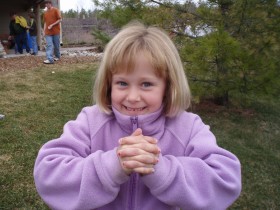TRAILS: Poor and deteriorating. But the pussy willows are coming out!
Yes, the day before Easter, Crossroads at Big Creek will hold “that egg thing” again. EGGstravaganza is our annual celebration of eggs, but it is not a hunt. Instead, learners of all ages explore the wonders of eggs…..the strength, the shape, the variations. Last year, the explorations took place outside on lush green grass. But whatever the weather, we will hold the event on Saturday, March 30 at 1:00.
Boiled eggs are significant in the commemorations of several religious holidays. So this week, many people will be cracking and peeling eggs. But perhaps because they are so familiar, we seldom take the time to appreciate that eggs are structurally beautiful…amazing really.
Consider that the thin shell must be strong enough to protect the embryonic chick from the being squashed by a setting hen. And the egg shape is much stronger than a cube. The egg shape is so remarkably strong because the rounded end is rather like a dome, an architectural form constructed as to exert an equal thrust in all directions. The the mother bird does not break the shell because no single point on the supports her weight.
But don’t assume all bird eggs are shaped like the eggs of domestic chickens. Some wild birds have eggs which are almost round. Other eggs are so tapered at one end that they are almost pointed. The shape of an egg is usually determined by the nest environment.
Birds that nest in holes tend to have the spherical eggs. Spheres are very strong, but they roll. But in a deep cavity nest, rolling eggs have nowhere to go. In contrast, birds that nest on cliffs have very tapered eggs. And that a good thing. If a cone-shaped egg moves, it will roll in a tight circle rather than plummet over the edge.
Those that nest on bare ground tend to lay very tapered eggs. In fact, most shorebirds lay four eggs which they arrange with the pointed ends toward the middle so they fit together like the pieces of a pie. Not only are they less likely to roll away, but fitting close together with very little space in between them, the tapered eggs actually keep each other warm.
A round or tapered egg is much easier to lay than, say, a cube (ouch!) but I was surprised to learn that the blunt end comes out first. It seems that as the mother bird pushes the egg out of her oviduct, she squeezes with her muscles, and on the final push, she squeezes harder, so the not completely hardened shell becomes pointed on one end. (Apparently, as a hen ages, her eggs become rounder because her muscles aren’t as strong as those of a spring chicken.)Learners of all ages are welcome to participate in this EGGciting annual activity.
On Tuesday, April 2, at 7:00 the Door Peninsula Astronomical Society will hold April meeting at the Stonecipher Astronomy Center. Program ” Apps for Astronomy” will be presented by Dave Udell & Tom Minahan. Dr. John J. Beck will present the Viewing Target of the Month. Refreshments will be served. Visitors are encouraged to attend the meeting.
However, the Learning Center will be closed on Easter Sunday and the will be no Community Ski.

